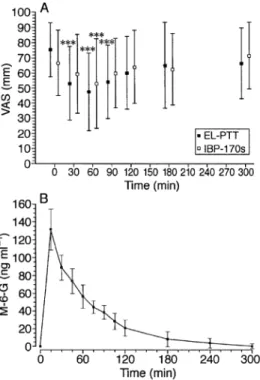Analgesic action of i.v. morphine-6-glucuronide in healthy volunteers
Texte intégral
(2) Buetler et al.. Comment We have demonstrated that M-6-G has analgesic activity in human volunteers after i.v. application when appropriate and sensitive pain tests are used, corroborating earlier studies in patients and healthy subjects.2 In contrast, a recent placebo- and morphine-controlled study3 reported a lack of analgesic activity after constant infusion of M-6-G, although steady-state M-6-G plasma concentrations (70– 175 ng ml–1) were similar to those in our study (90–228 ng ml–1). However, the study of Loetsch and colleagues3 must be interpreted with caution because of the very high incidence of opioid effects and use of naloxone and antiemetics almost exclusively in the morphine group. The resultant unblinding may have prejudiced volunteer reactions and it is possible that the rescue medication itself had effects on nociception. Moreover, the pain-evoked cerebral late potentials used in their study are recognized to be multifactorial in origin and cannot be assumed to measure sensory discriminative responses to pain, but rather reflect emotional–motivational aspects of pain.5 Late potentials of this type are particularly sensitive to non-analgesic sedation, as seen in the morphine but not in the M-6-G or placebo groups in the study of Loetsch and colleagues. Because of the difficulties of true blinding in opioid medication groups, we chose an open study design. The choice of tests for demonstration of opioid analgesia is crucial, as phasic, mainly A-δ fibre activating stimuli, as used by Loetsch and colleagues, have been shown to be insensitive for this purpose.6 The tonic and suprathreshold pain tolerance tests in our study were chosen to ensure activation of C-fibres sensitive to opioid effects. Although qualitative responses to electrical and cold pain stimulation were similar, the former is a multimodal stimulus and the latter probably monomodal. Clinical studies with patients are now necessary to further evaluate the therapeutic potential of M-6-G.. Fig 1 Antinociceptive effects and plasma concentrations of M-6-G. A: Mean (SD) visual analogue pain scores (VAS) of pain intensity (0⫽no pain, 100⫽unbearable pain) during ice bucket immersion and electrical stimulation at 200% pain tolerance thresholds in 12 healthy volunteers. EL-PTT⫽Electrical pain tolerance thresholds, IBP-170s⫽ice bucket pain test lasting 170 s. ***P⬍0.001 vs pre-M-6-G baseline. B: Mean (SD) plasma concentrations of morphine-6- glucuronide (M-6-G).. Statistical analysis was performed using analysis of variance (ANOVA) and post hoc Tukey’s honest significance test. P⬍0.05 was considered significant. Concentrations of M-6-G, M-3-G and morphine in plasma were assayed by high-pressure liquid chromatography with diode-array detection (HPLC-DAD).4 All 12 volunteers completed the pain tests. There were no serious or objective side effects. Subjective effects were sensations of heaviness, warmth and faster pulse (12 of 12 subjects), nervousness (seven), shortness of breath (three) and localized rash (three). The time–effect for pain intensities during both the ice bucket and electrical pain tests was highly significant (P⬍0.0001) (Fig. 1A). Pain intensities during electrical stimulation were significantly lower than baseline at 30, 60 and 90 min after administration of M-6-G (P⬍0.0005). With the ice bucket test, pain intensity at 60 min was significantly lower than that at baseline (P⫽0.004). At other times differences were not significant. In two subjects who received oral M-6-G, no effects on nociception were observed. M-6-G was present in plasma only after i.v. administration. Peak plasma concentrations of M-6-G of 90–228 ng ml–1 (mean 139.3 (SD 38.9) ng ml–1) were measured at 15 min (Fig. 1B). Morphine was not detectable.. Acknowledgements This work was supported by the Bernese Office of Industry and Labour (project No. BEA1 97–815), the Institute of Medical Oncology and the Nociception Research Group of the University of Bern. The gift of M-6-G by Lipomed is kindly acknowledged.. References 1 Milne RW, Nation RL, Somogyi AA. The disposition of morphine and its 3- and 6-glucuronide metabolites in humans and animals, and the importance of the metabolites to the pharmacological effects of morphine. Drug Metab Rev 1996; 28: 345–472 2 Thompson PI, Joel SP, John L, Wedzicha JA, Maclean M, Slevin ML. Respiratory depression following morphine and morphine-6glucuronide in normal subjects. Br J Clin Pharmacol 1995; 40: 145–52 3 Loetsch J, Kobal G, Stockmann A, Brune K, Geisslinger G. Lack of analgesic activity of morphine-6-glucuronide after short-term intravenous administration in healthy volunteers. Anesthesiology. 98.
(3) Analgesic action of i.v. morphine-6-glucuronide. 1997; 87: 1348–58 4 Bourquin D, Bundeli P, Lehmann T, Brenneisen R. Diacetylmorphine and its metabolites in plasma by HPLC with diode-array and atmospheric pressure ionization mass spectrometric detection. J Liquid Chromatogr Related Technol (in press). 5 Zaslansky R, Sprecher E, Katz Y, Rozenberg B, Hemli JA, Yarnitsky D. Pain-evoked potentials: what do they really measure? Electroencephalogr Clin Neurophysiol 1996; 100: 384–91 6 McCormack K, Prather P, Chapleo C. Some new insights into the effects of opioids in phasic and tonic nociceptive tests. Pain 1998; 78: 79–98. 99.
(4)
Figure

Documents relatifs
En mathématiques, une suite de Syracuse est une suite d'entiers naturels définie de la manière suivante : le premier terme est un nombre entier plus grand que zéro ;
En mathématiques, une suite de Syracuse est une suite d'entiers naturels définie de la manière suivante : le premier terme est un nombre entier plus grand que zéro ;
La souplesse d'utilisation des nombres de Lelong g6n6ralis6s permet d'ob- tenir aussi des d6monstrations tr~s simples de r6sultats classiques concernant les
[r]
Capacité : Ajouter ²un ²petit nombre à ²une dizaine ²entière.... Capacité : Retrancher ²un
Iæ candidat in- diquera sur la copie le numéro de la question et la lettre correspondant à la réponse choisie. Âucune justification rlest
[r]
(2) &i,a2,. One shows straightforwardly that n acts trivially on any finite dimensional irreducible b-module, and thus, as in the usual case of Lie algebras, the above